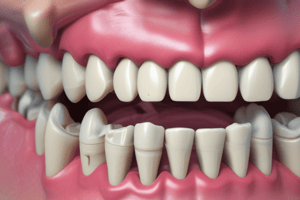Podcast
Questions and Answers
Which of the following structures serves as the anterior boundary of the oral cavity?
Which of the following structures serves as the anterior boundary of the oral cavity?
- Upper lip (correct)
- Hard palate
- Soft palate
- Alveolar process
What is the function of the periodontal ligament?
What is the function of the periodontal ligament?
- To secrete saliva into the oral cavity
- To anchor the tooth to the surrounding bone (correct)
- To provide sensation to the tooth
- To produce enamel for the tooth
Which of the following is NOT a part of a tooth?
Which of the following is NOT a part of a tooth?
- Cementum
- Dentin
- Enamel
- Gingiva (correct)
What is the function of the buccinator muscle in relation to the oral cavity?
What is the function of the buccinator muscle in relation to the oral cavity?
What is the name of the bony structure that forms the posterior boundary of the oral cavity?
What is the name of the bony structure that forms the posterior boundary of the oral cavity?
What is the average age when the deciduous mandibular incisors emerge in the oral cavity?
What is the average age when the deciduous mandibular incisors emerge in the oral cavity?
What are the teeth called that erupt at birth?
What are the teeth called that erupt at birth?
At what age do third molars ideally erupt?
At what age do third molars ideally erupt?
Why are third molars also called wisdom teeth?
Why are third molars also called wisdom teeth?
What is the sequence of tooth eruption in the oral cavity?
What is the sequence of tooth eruption in the oral cavity?
What is the ideal age for the eruption of permanent second molars?
What is the ideal age for the eruption of permanent second molars?
In what week do the deciduous mandibular incisors ideally erupt?
In what week do the deciduous mandibular incisors ideally erupt?
What is the significance of the age of 5 years in tooth eruption?
What is the significance of the age of 5 years in tooth eruption?
Why is it important to track the sequence of tooth eruption?
Why is it important to track the sequence of tooth eruption?
What is the relationship between the eruption of permanent second molars and third molars?
What is the relationship between the eruption of permanent second molars and third molars?
Flashcards are hidden until you start studying
Study Notes
Oral Cavity Boundaries
- The oral cavity is bounded by several structures that form its walls and floor
- The boundaries of the oral cavity include:
- Roof: hard palate and soft palate
- Floor: tongue and muscles of the floor of the mouth
- Anterior wall: teeth, gingiva, and upper and lower lips
- Lateral walls: cheeks and teeth
- Posterior wall: oropharyngeal isthmus (the opening that leads to the oropharynx)
Tooth Structure
- A tooth consists of:
- Crown: the visible part of the tooth above the gum line
- Root: the part of the tooth below the gum line
- Enamel: the hard, outer layer of the crown
- Dentin: the layer beneath the enamel, making up most of the tooth
- Cementum: the thin layer of bone-like tissue covering the root
- Pulp: the soft tissue inside the tooth containing nerves and blood vessels
Supporting Structures of a Tooth
- Periodontium: the tissues surrounding and supporting the tooth, including:
- Gingiva (gums): the mucous membrane covering the alveolar process
- Periodontal ligament: the connective tissue attaching the tooth to the alveolar process
- Alveolar process: the bony socket holding the tooth in place
- Cementum: the thin layer of bone-like tissue covering the root
- Bone: the jawbone that forms the socket for the tooth
Development and Eruption of the Teeth
- As a dentist, it is essential to know and memorize the sequence and ideal age of eruption of teeth into the oral cavity to diagnose oral conditions of patients.
- Premature eruption or exfoliation of teeth can be an indicator of oral conditions.
- Knowledge of tooth eruption sequence and age can help determine a person's age by examining their mouth, oral radiographs, or photographs.
Deciduous and Permanent Dentition
- The first teeth to emerge in the oral cavity are the deciduous mandibular incisors, which erupt at an average age of 6 months post-natal.
- In some cases, teeth may be already erupted at birth, known as neonatal teeth.
Third Molars (Wisdom Teeth)
- Third molars ideally erupt as early as 5 years after the eruption of the permanent second molars, which is around 17 years old up to 21 years old.
- Third molars are also called wisdom teeth.
Sequence of Eruption of Teeth
- The sequence of eruption of both deciduous and permanent dentition is essential to learn by rote.
- The ideal age of eruption of all teeth must be remembered and recalled.
Studying That Suits You
Use AI to generate personalized quizzes and flashcards to suit your learning preferences.



